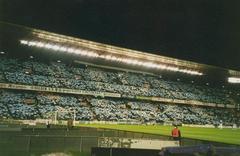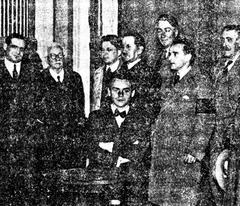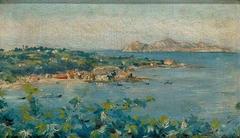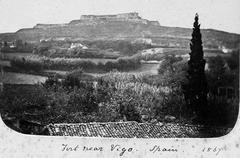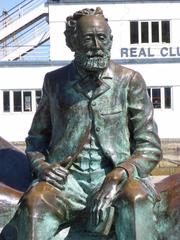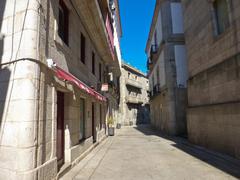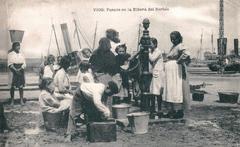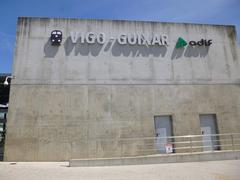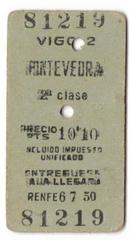Museo Quiñones de León Visiting Hours, Tickets, and Guide – Vigo, Spain
Date: 15/06/2025
Introduction
The Museo Quiñones de León, located in the historic Castrelos pazo of Vigo, Spain, is a showcase of Galician art, history, and aristocratic heritage. Since opening as a municipal museum in 1937—after the estate’s donation by Fernando Quiñones de León in 1925—the museum has offered a captivating window into Vigo’s cultural evolution. Visitors encounter elegant period rooms, one of Galicia’s best collections of regional art, and archaeological finds that trace the area’s ancient roots.
The museum is equally renowned for its expansive gardens, blending French formal and English landscape styles, and botanical treasures like the Camellia Matusalén—one of the oldest camellias in Galicia. Together, the mansion and gardens provide a multifaceted cultural experience, making the Museo Quiñones de León a must-visit for art lovers, history enthusiasts, and travelers alike.
For up-to-date information on visiting hours, tickets, accessibility, and current exhibitions, consult the official Museo Quiñones de León website and the Vigo tourism portal.
Contents
- Overview: History and Cultural Significance
- Artistic Collections and Permanent Exhibitions
- Temporary and Special Exhibitions
- Museum and Gardens: Layout, Accessibility, and Highlights
- Visitor Information: Tickets, Hours, and Getting There
- Gardens: Design, Botanical Highlights, and Seasonal Tips
- Frequently Asked Questions (FAQs)
- Summary and Final Tips
- Sources and Further Reading
Overview: History and Cultural Significance
The Museo Quiñones de León is housed in the 17th-century Castrelos pazo, a prime example of Galician noble architecture. The pazo—expanded and remodeled in the late 19th and early 20th centuries—was transformed into a museum in 1937 to safeguard local heritage (Museos de Galicia).
Its interiors preserve the refined lifestyle of Galician aristocracy, with authentic period furnishings and décor. The museum’s gardens, designed by Jacinto de Matos in 1890, blend French symmetry and English naturalism, reflecting the cosmopolitan tastes of Galicia’s elite (WhichMuseum).
The museum has become a vital cultural hub, not only for its collections but also for its role in community events, educational activities, and the preservation of regional identity.
Artistic Collections and Permanent Exhibitions
Decorative Arts and Noble Ambience
The ground floor recreates the atmosphere of a Galician aristocratic residence, displaying original and period furnishings, ceramics, porcelain, silverware, clocks, textiles, and glass—many from the legacy of philanthropist Policarpo Sanz (Museos Xunta; Ayuntamiento de Vigo). Stately rooms such as the marquess’s office and dining room immerse visitors in the lifestyle of the nobility around the turn of the 20th century (Aguias de Vigo).
European Painting Collection
The museum boasts a significant collection of 17th- to 19th-century European paintings, largely donated by Policarpo Sanz, as well as works from the Museo del Prado and the former National Museum of Modern Art (Turismo de Vigo). These works are displayed throughout the museum’s 29 exhibition halls, primarily on the ground floor.
Galician Art of the 20th Century
Upper floors feature the most comprehensive public collection of 20th-century Galician art, tracing a journey from early regionalism through to contemporary trends. The collection includes paintings, sculptures, and mixed media by leading Galician artists (Ayuntamiento de Vigo).
Archaeological Collection
A dedicated annex and exhibition hall present archaeological artifacts from Vigo and southern Pontevedra, covering the Paleolithic to the Middle Ages. Highlights include Roman funerary stelae, castro artifacts, and late Roman slabs, all contextualizing the ancient history of the region (Turismo de Vigo; Ayuntamiento de Vigo).
Reconquista Room
This room commemorates Vigo’s liberation from the French during the Peninsular War, displaying banners, memorabilia, and Marshal Soult’s saber as a testament to the city’s resilience (Aguias de Vigo).
Temporary and Special Exhibitions
Centenary Celebrations and Recent Acquisitions
2025 marks the centenary of Fernando Quiñones de León’s donation, celebrated with special exhibitions such as “Recordos do Marqués de Alcedo,” which includes new acquisitions and personal mementos of Antonia de Bañuelos (Faro de Vigo). The centenary program features lectures, guided tours, and workshops on landscape restoration.
Rotating Art and Archaeology Exhibitions
Temporary exhibitions explore themes in Galician art and recent archaeological discoveries, appealing to families, students, and art aficionados (Turismo de Vigo).
Museum and Gardens: Layout, Accessibility, and Highlights
Layout and Accessibility
The museum spans 29 halls across three main floors and an archaeological annex (Museos Xunta). The ground floor evokes the stately home, upper floors focus on Galician art, and the annex presents archaeological material.
Accessibility is a priority, with ramps, elevators, and the award-winning Sensory Garden designed for visually impaired visitors (Turismo de Vigo).
Gardens as Living Exhibitions
The 24-hectare Castrelos Park is integral to the museum experience. Redesigned in the 19th century, the gardens are divided into:
- French Garden: Formal parterres, box hedges, and the Príncipe de las Aguas fountain.
- Rose Garden: Seasonal floral displays.
- English Garden (“Pradera del Té”): Informal lawns and winding paths (Spain.info).
The gardens host concerts, art events, and community gatherings.
Visitor Tips
- Sensory Garden: A multisensory space, especially valuable for visually impaired visitors.
- Seasonal Highlights: Camellia blooms in winter and spring; rose gardens in early summer.
- Guided Tours: Highly recommended for deeper insight; available by appointment.
Visitor Information: Tickets, Hours, and Getting There
Museum and Gardens Visiting Hours
- Gardens: Open daily, 9:00 AM – 9:00 PM.
- Museum: Tuesday–Saturday, 10:00 AM – 7:00 PM; Sunday, 10:00 AM – 3:00 PM. Closed Mondays and public holidays. Hours may vary seasonally (Turismo de Vigo).
Tickets and Prices
- Gardens: Free admission.
- Museum: Standard tickets €3 adults; reduced rates for students, seniors, and groups. Special exhibitions may have separate pricing. Purchase on-site or online via the Vigo tourism site.
Getting There
- Public Transport: Bus lines 9, 10, and 11 connect the city center to Castrelos.
- Car: Limited parking available near the museum.
- On Foot: Accessible from downtown Vigo.
Accessibility
Partial accessibility for those with reduced mobility; some areas have uneven terrain. For specific needs, contact the museum in advance.
Photography
Allowed in most permanent exhibitions; restrictions may apply in temporary exhibits—check signage or ask staff.
Gardens: Design, Botanical Highlights, and Seasonal Tips
Historical Evolution and Design
The gardens reflect centuries of aristocratic tradition, blending French formality with English romanticism. Ancient cypresses, magnolias, a dovecote, and chapel contribute to the estate’s historical authenticity (official Museo Quiñones de León website).
Botanical Treasures
- Camellia Matusalén: The oldest camellia in Galicia, emblematic of the region’s horticultural legacy.
- Seasonal Blooms: Camellias and azaleas in spring, roses in summer, vivid foliage in autumn.
Visiting Tips
- Early mornings and late afternoons offer the best photography conditions.
- Waterproof shoes are recommended in winter.
- Pets are not permitted.
Nearby Attractions
Combine your visit with Vigo’s Old Town, the Castro Fortress, or the Museo do Mar de Galicia for a complete cultural day.
Frequently Asked Questions (FAQs)
Q: Is entry to the gardens free?
A: Yes, gardens are free to enter year-round.
Q: What are the museum ticket prices?
A: €3 for adults; reduced rates available.
Q: Are tours available in English?
A: Tours are mainly in Spanish and Galician; check in advance for English options.
Q: Is the museum fully accessible?
A: Most areas are accessible; contact the museum for details.
Q: Is photography allowed?
A: Yes, except in some temporary exhibitions.
Q: Are pets allowed?
A: No, pets are not permitted.
Summary and Final Tips
The Museo Quiñones de León offers a rich immersion into Galicia’s cultural, artistic, and botanical history. With authentic period rooms, outstanding art collections, and splendid gardens, the museum is a highlight for any Vigo itinerary. Facilities are accessible, guided tours provide added value, and regular special events keep the experience fresh.
Plan ahead by checking the latest hours and ticket info on official sites. For a deeper experience, use digital resources like the Audiala app for audio guides and updates, and follow museum channels for news on exhibitions and activities.
For more, visit the Museo Quiñones de León official site and the Vigo tourism website.
Sources and Further Reading
- Museo Quiñones de León, 2025, Xunta de Galicia
- Museo Quiñones de León Visitor Guide, 2025, WhichMuseum
- Vigo Cultural Attractions, 2025, OnlyByLand
- Museo Quiñones de León Collections and Exhibitions, 2025, Ayuntamiento de Vigo
- Museo Quiñones de León Art and Archaeology, 2025, Turismo de Vigo
- Museo Quiñones de León Gardens Guide, 2025, Official Museo Quiñones de León website
- Centenary Celebrations at Museo Quiñones de León, 2025, Faro de Vigo
- Museo Quiñones de León Gardens, 2025, Spain.info
- Guided Tours and Visitor Tips, 2025, Aguias de Vigo
